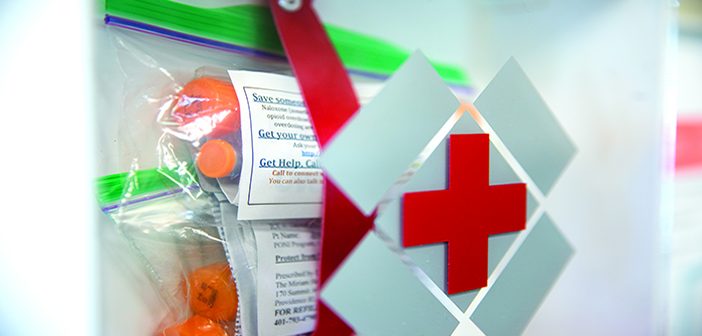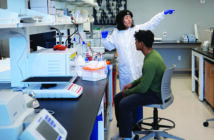A doctor-designer collaboration puts a lifesaving drug in the public’s hands.
No one remedy can turn around a crisis as complex as the opioid overdose epidemic. But there’s only one “resurrection drug.”
“Literally, a person is on the brink of death, blue from lack of oxygen, and you give them naloxone, and they can wake up and talk to you,” says Geoff Capraro, MD, MPH, assistant professor of emergency medicine.
Capraro, a University Emergency Medicine Foundation physician in the pediatric emergency department at Hasbro Children’s Hospital, doesn’t see too many overdoses on the job. But the lifesaving potential of naloxone, which restores normal breathing in someone who’s overdosed on heroin or prescription painkillers, and its relative ease of use, got him thinking about how to get the medication into the hands of the lay public.
“Imagine how troubling it would be if you were a bystander who knew it was an overdose, who knew the number one thing you needed was naloxone, and you had to wait seven minutes for an ambulance to come to give it,” Capraro says. “What a shameful situation for somebody to die.”
Inspired by the utility and ubiquity of fire extinguishers and AED boxes, last year Capraro crossed town to the Rhode Island School of Design, where he ultimately connected with Claudia Rébola, PhD, then an associate professor in the Industrial Design department, who specializes in designing health technologies. “We really tried to design a product that … [is]approachable and friendly, that people don’t feel intimidated in using it,” she says. “We cannot put visual or physical barriers for people to be empowered to save lives.”
Capraro and Rébola’s finished product, the NaloxBox, is accessible and familiar. A white, wall-mounted cabinet sporting a red cross on its transparent, Velcro-latched cover, it houses four doses of naloxone, a CPR mask, gloves, and instructions. They’ve installed the boxes and provided training at social services agencies and community health organizations throughout Rhode Island, as well as Providence City Hall, with more public locations to come. “It’s a statement from the business or the facility [that says]‘we’re taking this epidemic of deaths seriously,’” Capraro says.
So far they’ve received two mini-grants from the Rhode Island Department of Health to build 84 units; the
drugs were donated by an overdose prevention program at The Miriam Hospital. With only enough money for materials, they roped in family members to help build the boxes by hand, at Rébola’s house, this summer. But as inquiries have rolled in from across the country and Canada, Capraro and Rébola are seeking funds to scale up manufacture and distribution. They hope the Social Enterprise Greenhouse in Providence, which selected NaloxBox for its health and wellness accelerator this fall, will bolster that growth.
“This is one way in helping the epidemic, and there are many, many other ways to do it,” Rébola says. “Our first priority is, let’s try to save lives by providing the naloxone to people.”




